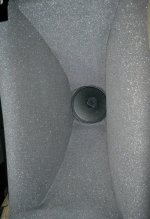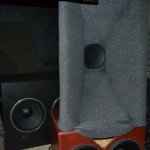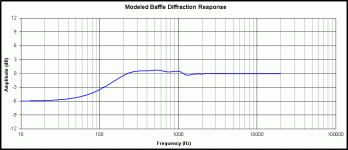A small update...
I have just posted an updated description of my project at Project | Homebuilt Hi-Fi - A user submitted image showcase of high quality home built hi-fi components., for those who might be interested.
Cheers,
Marco
I have just posted an updated description of my project at Project | Homebuilt Hi-Fi - A user submitted image showcase of high quality home built hi-fi components., for those who might be interested.
Cheers,
Marco
Very nice work, Marco!
Thank you Sir - I think the same of what you've done.
Too bad that we're too far apart for dropping by for a listen!
(But if you're ever in London... let me know by PM!)
Regards,
Marco
Likewise 'nice work' from me, Marco.
Is the three-way system your favoured set-up at the moment, or the five-way system ?
I like your observations on woofers. Is there a reason you look at Fs/Qms instead of comparing Rms for the drivers ? I've recently been looking at Rms (low) or Qms ( high ) for mid or bass drivers myself- would be interesting to hear your thoughts.
Is the three-way system your favoured set-up at the moment, or the five-way system ?
I like your observations on woofers. Is there a reason you look at Fs/Qms instead of comparing Rms for the drivers ? I've recently been looking at Rms (low) or Qms ( high ) for mid or bass drivers myself- would be interesting to hear your thoughts.
I agree! Great work, Marco! I like seeing the creative vision of different people from around the world. Having recently seen the RMAF audio show in Denver, there still aren't a lot of "audiophile" speakers that are based on 2+ way large-format studio monitor.
Likewise 'nice work' from me, Marco.
Thanks!
Is the three-way system your favoured set-up at the moment, or the five-way system ?
The three-way system is my favourite.
I can think of a number of reasons why this is the case. In likely order of decreasing importance:
1. The crossover.
The one for the three-way has been the object of a careful and lengthy optimization process, with many measurements and simulations. It also employs much higher quality parts (transformer attenuator for the compression driver, Jantzen Superior Z capacitors, Mundorf low-DCR coils, etc.).
The one for the five-way system (actually, a four-way passive crossover plus a DSP-controlled active sub) was instead put together rather quickly at a friend's place, in another country. While already good, it is certainly not as optimized as that of the three-way system.
2. The horns.
Those for the five-way system are older Fostex units that have a wider horizontal dispersion (140º vs 110º for the newer one used in the three-way system); this gives them a more extreme W:H aspect ratio, and makes them behave a bit more like 'diffraction' horns (the 'lips' are also thinner, which compounds the effect by causing more diffraction at the mouth).
3. The compression drivers.
The Fostex D1400 driver used in the three-way system is very smooth and subjectively 'sweeter' sounding than either of the ferrite units used in the five-way system. OTOH, this might in fact mostly be a consequence of the different crossover (point 1 above).
4. Maybe there's something to be said for avoiding a crossover point right in the middle of the ear's most sensitive range (1-5kHz)? I'm not sure.
All of this is not to say that the 5-way system is bad. It isn't. It's actually a rather good sounding system! It's just that the 3-way system sounds just a little bit better to me in most meaningful ways.
I like your observations on woofers. Is there a reason you look at Fs/Qms instead of comparing Rms for the drivers ? I've recently been looking at Rms (low) or Qms ( high ) for mid or bass drivers myself- would be interesting to hear your thoughts.
Rms is a fundamental 'lumped' parameter that expresses the mechanical static friction (a.k.a. 'stiction') caused by the surround/spider/voice coil, and is measured in units of force over velocity (speed): [N/(m/s)].
It can also be intended as a ratio of impulse [N*s] to displacement [m], i.e., the higher Rms, the higher the (counter)-impulse generated per unit of diaphragm displacement.
My reasoning is that the same amount of friction (in absolute terms) will have a different effect depending on the mass that is being moved. Just think of the friction that's needed to be able to walk on slippery ice: the heavier you are, the more friction you need!
In more formal physical terms, it is the coefficient of friction that ultimately matters, not the friction itself.
So, going back to our Woofer, I think we need to actually look at the ratio of Rms to moving mass, i.e.: Rms/Mms.
Now, Qms is a derived parameter, defined as: Qms = sqrt(Mms/Cms)*1/Rms
Fs is also a derived parameter: Fs = 1/(2*Pi*sqrt(Cms*Mms))
So if we take the ratio of Fs to Qms, we find that: Fs/Qms = Rms/(2*Pi*Mms)
which is essentially the same as the Rms/Mms ratio (apart from a constant coefficient = 1/(2*Pi)).
Hence my reasoning for comparing Woofers based on their Fs/Qms ratios.
Interestingly, Fs/Qms is the mechanical homologue of Fs/Qes (the well-known "Efficiency Bandwith Product", which indicates the amount of electrical damping).
Similarly, Fs/Qms indicates the 'mechanical damping', and then Fs/Qts = Fs/Qes + Fs/Qms is the 'total damping' (which determines the lumped low-frequency behaviour of the Woofer, and is used for instance in calculating the optimal bass-reflex tuning frequency). But I digress...
Marco
Hello Marco, I did not see - do you use baffle step correction for the bass? Is this speaker over 90 db/w/m sensitive? How do you find the fostex attenuators for fine adjustments?
Thanks
Thanks
Hello Marco, I did not see - do you use baffle step correction for the bass?
No, I do not.
As you can see in the attached graph, the wide baffle pushes the 'step' frequency down to below 200Hz (i.e., into the modal region), and the speakers are positioned very close to the front wall.
Yes, it is ~93 dB/W(m).Is this speaker over 90 db/w/m sensitive?
They work just fine. The transformer-based attenuators (R100T) make it easier to match L & R as they are stepped (instead of continuously variable).How do you find the fostex attenuators for fine adjustments?
Attachments
Thanks for the interesting discussion of mechanical damping, Marco.
I've saved that posting for future reference.
I've saved that posting for future reference.
I've been thinking about that Fs/Qms measure Marco, and I'm not 100% convinced it's the answer. I'm not doubting the logic of what you wrote, but it does seem some pretty big high power drivers could look very good on Fs/Qms, but pretty bad on Rms - for instance try the B&C 21SW150 ( 3.6 ; but Rms 10.7 ) .
I'm wondering if there's another factor coming in to picture : the excursion level for a fixed SPL drops as the cone area increases.
I haven't got enough drivers of the right type to prove if this theory has any merit - so I'll just have to leave it as a theory for now !
Your Fostex 405 measures well on both 'rules of thumb', so that's not a problem .
One other nice driver I found and would like to try one day as a sealed-box bass is the SB Acoustics SB34NRX75-6 - seems to tick all the boxes .
I'm wondering if there's another factor coming in to picture : the excursion level for a fixed SPL drops as the cone area increases.
I haven't got enough drivers of the right type to prove if this theory has any merit - so I'll just have to leave it as a theory for now !
Your Fostex 405 measures well on both 'rules of thumb', so that's not a problem .
One other nice driver I found and would like to try one day as a sealed-box bass is the SB Acoustics SB34NRX75-6 - seems to tick all the boxes .
Curious about the horn (if any) in front of the 12" Tannoy and what handles the range above the top of the internal HF horn of the Tannoy.
Coming together, deep bass cabinets are tuned but not integrated with the main speakers or subs yet. From 100 cycles up it's probably the best I have had. The highs are very nice detailed and coherent. No super tweeter needed. With the finished crossover it's more extended than virtually all 1" compression drivers I have. The TAD 2001 may be a bit brighter but I never got it to sound this good. Maybe this weekend. 🙂


I have just posted an updated description of my project at Project | Homebuilt Hi-Fi - A user submitted image showcase of high quality home built hi-fi components., for those who might be interested.
Cheers,
Marco
How can you live with a large coil in the midrange crossover? Compare it to bi-amping and you will hear what I mean.
How can you live with a large coil in the midrange crossover? Compare it to bi-amping and you will hear what I mean.
The "large coil" in the midrange crossover is a low-DCR Mundorf i-core coil in parallel to the compression driver, and it has no audible ill effect.
Marco
One thing about passive XOs- when done artfully, you can come up with more complex transfer functions than the simplicity of line-level passive or active conventional filters.
Of course, that pales in comparison with full-bird DSP solutions (or more complex line-level filters), but skilled use of passive, speaker level XOs can come up with some pretty elegant shaping solutions and low coloration.
Of course, that pales in comparison with full-bird DSP solutions (or more complex line-level filters), but skilled use of passive, speaker level XOs can come up with some pretty elegant shaping solutions and low coloration.
My midrange compression driver varies between 8-20 ohm in impedance around 500-2500Hz, and the highest peaks are around 200-1000 Hz, right where I want to protect it from bass with a passive 2nd order crossover.
Rewind, if you pass the impedance into a simulator (with or without the response measurement) you can find a pair of RLC to use on the impedance, design once, solder and leave. Wrap the L-pad around it. Further, the 2nd order filter has a degree of load variation immunity, but using all three methods should put you in the clear.
I read somewhere that impedance rises close to the Fc can not be fixed with a zobel. Maybe the same goes for RLC networks.
Excuse me redefining, but a Zobel network is supposed to conjugate impedance regardless of the circuit used, so same diff. But you can do this to any part of the impedance.I read somewhere that impedance rises close to the Fc can not be fixed with a zobel. Maybe the same goes for RLC networks.
I use two RLCs to deal with my two and a half peak compression driver resonance, which brings it to (IIRC) half an ohm +/- or so. Getting this close with an L-pad takes at most (again IIRC) around 2.5 ohms across the driver.
Either way there is some peaking with simple high-pass filtering that is easier to deal with using the notch filters and L-pad together.
- Home
- Loudspeakers
- Multi-Way
- Beyond the Ariel
